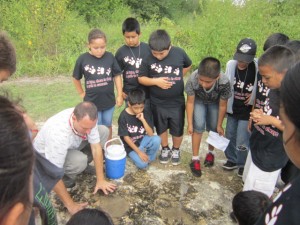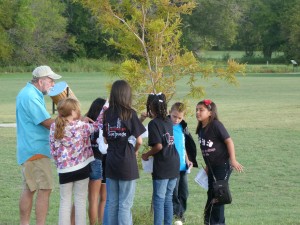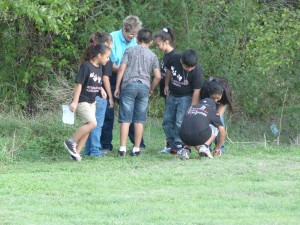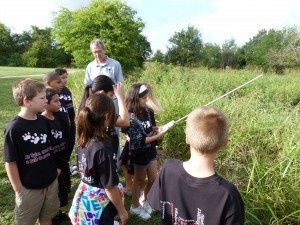Belton ISD fourth-graders take hands-on approach to science
October 2012

Dr. June Wolfe of Texas A & M AgriLife Research creates a watershed model out of exposed limestone at Friar’s Creek. Photo by Rehanon Pampell
Rehanon Pampell, project coordinator for the Blackland Research & Extension Center in Temple, asked the students what science was and why it is important. “Science helps us study stuff,” she said. “Why do we study stuff? We’re curious. … You need curiosity to look at one tree and see how it’s different from another tree, and to find out why and how things work. Being a scientist is not all about being in a lab with test tubes.”
The students were sent on an eco scavenger hunt to help spark their interest in the world around them.
They were asked to find three kinds of rocks, three unusually shaped leaves, different textures, different odors or smells, three objects with different colors, evidence that animals were around and evidence that people were around.
They also were asked to find something that depends on something else, something that is good at hiding, something that spreads seeds, natural patterns or designs, a natural warning, something that can’t be replaced once it is used up and something extraordinary.
Master naturalists accompanied the students on the scavenger hunt.
“Write down what you see today, and you’ll get a good look at what it’s like to be a scientist,” Pampell said.
Tyler students visited the Blackland Research Center during the previous school year, and Pampell said this year, representatives of the center wanted to give the students a chance to get outside to a more natural area and give them a chance to do some field research.
The goal was to use their observation skills to better understand the world around them, and to learn what environmental scientists do.
Some of the evidence of people included litter in the park’s creek.
“It takes thousands of years for that to disintegrate,” master naturalist Darla Menking told the students.
They also observed large green horse apples — also known as Osage oranges — fruit from the bodark or Bois d’arc trees, and how they floated on water because they were buoyant — and water is heavier than the fruit.
The students learned how the vines with purple flowers in the park wrap themselves around stronger plants for support, and grow toward sunlight.
When observing ditches, Menking explained that soil erosion caused by water causes dirt to slide away, creating cracks and ditches.
She said plant life is important to prevent soil erosion, because the roots of plants give soil more stability.
Evidence of animals being presented included duck tracks, the sounds of birds singing, leaves being eaten from a tree by insects, and small fish and crawfish being observed in the creek.

Central Texas Master Naturalist, Tom Olsen, has Belton ISD’s Tyler Elementary fourth grade students using thier senses (looking, feeling, and smelling) to investigate a bald cypress tree. Photo by Jerry Lewis
The students also were able to observe snails with spiral patterns on their shells.
“What do snails eat?” Menking asked the students. “They’re notorious for eating the soft petals of flowers and plants, so we don’t like them in our gardens. They don’t do it to be mean, that’s just what they eat.”
The students observed how webworms devour leaves and can harm trees, and they watched dragonflies and damsel flies flitter about at the park.
Dr. June Wolfe, a research scientist who studies biology and water quality, talked to students about his job.
“Bio means life, so biology is the study of life,” he said. “What things are alive? Plants, animals, people, bacteria …
“I like to study things that live in water. What lives in water? Insects and plants — lots of things live in water.
He held up a large container filled with algae and insects, and said that was an ecosystem, because things were living in it. He said that eco is the Greek word for home or house.

Central Texas Master Naturalist President, Mary Ann, captures the attention of Belton ISD’s Tyler Elementary fourth grade students. Photo by Jerry Lewis
“Water is really, really important, and it’s good to understand watersheds,” Wolfe said.
He said that a watershed is an area where runoff occurs, and that it’s important to keep watersheds clean and free from pollution.
“It’s really important to think about watersheds and the quality of water,” Wolfe said. “What is water quality? It’s how good the water is for supporting life and for people to drink.”
He had the students measure an area of the park which he defined as a watershed, and told them that one cubic foot of space holds 7.5 gallons of water, so during heavy rains, there was a lot of water pouring from a watershed.
“It can change the shape of land as it goes across an area,” Wolfe said. “Hydrology is the study of where water goes and how it moves across the landscape.

Dr. Jim Kiniry of USDA Agricultural Research Service demonstrated how he uses a ceptometer to measure light levels in an open canopy versus near the ground beneath a closed canopy. The kids discussed the affects different sizes and densities of plants might have on the amount of light that penetrates the ground and the plants and animals that live there. Photo by Jerry Lewis
Dr. Jim Kiniry, a research agronomist who studies plant and soil science, talked to students about the importance of biofuel, and how material from plants can help power vehicles and other machines.
He showed students the towering stalk of an energy sorghum plant, which helps provide material that is turned into fuel.
He also showed them how to use a light sensor, a device that measures the amount of light being captured by plants, which drives their growth.
One of the plants students observed was Johnson grass, a plant that was imported to America to provide food for livestock, but which spread quickly and is known as an invasive species, because it competes with native plants for resources.
Billie Bennett, a Tyler student, said she enjoyed “exploring nature” at the park.
“It was awesome,” she said.
Anthony Conway, another student, said he enjoyed seeing the horse apples in the trees, the snails and different types of leaves.
Student Leo Martinez said he enjoyed getting to enjoy nature as well.
“We got to see lots of plants that are growing here and learned about what animals eat,” he said, adding that he enjoyed seeing tadpoles in the creek.
